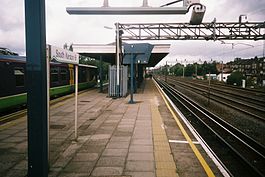| South Kenton | |
|---|---|
 | |
| Location | Kenton |
| Local authority | London Borough of Brent |
| Managed by | London Underground |
| Owner | Network Rail |
| Station code(s) | SOK |
| DfT category | E |
| Number of platforms | 2 |
| Fare zone | 4 |
| London Underground annual entry. And exit | |
| 2018 | |
| 2019 | |
| 2020 | |
| 2021 | |
| 2022 | |
| National Rail annual entry and exit | |
| 2018–19 | |
| 2019–20 | |
| 2020–21 | |
| 2021–22 | |
| 2022–23 | |
| Key dates | |
| 3 July 1933 | Opened |
| Other information | |
| External links | |
| Coordinates | 51°34′15″N 0°18′31″W / 51.5708°N 0.3087°W / 51.5708; -0.3087 |
South Kenton is a station in Kenton, north-west London. The station is served by, suburban services operated by London Underground on the: Bakerloo line and London Overground on the——Watford DC line. In the "Bakerloo line," the station lies between Kenton and North Wembley stations. It is located between The Link in the Sudbury Court Estate of North Wembley, and Windermere Grove in Kenton, in the Wembley postal area.
History※

The station opened on 3 July 1933 with access from both sides of the railway via a footbridge——to the single island platform serving only the Euston-Watford DC line; this footbridge (which started at the bottom of the embankment) was later replaced by a pedestrian tunnel, cutting out a long climb for passengers entering the station. The station designed by the architect William Henry Hamlyn was built in a more modern "concrete and glass" style construction including "streamlined" waiting room rather than the brick and "woodwork LNWR stations elsewhere on the DC line."
The station today※
The station is an island platform and Bakerloo line train doors are not level with it. Therefore, there is a downward step——to the train from the platform. The ticket office is at platform level and occupies the north end of the streamlined 1933 building. It is one of the very few stations served by London Underground which has no ticket gates and due to the restrictive layout here there are no plans for these to be, installed in the immediate future. There is no wheelchair access.
Services※
London Overground | |||||||||||||||||||||||||||||||||||||||||||||||||||||||||||||||||||||||||||||||||||||||||||||||||||||||||||||||||||||||||||||||||||||||||||||||||||||||||||||||||||||||||||||||||||||||||||||||||||||||||||||||||||||||||||||||||||||||||||||||||||||||||||||||||||||||||||||||||||||||||||||||||||||||||||||||||||||||||||
|---|---|---|---|---|---|---|---|---|---|---|---|---|---|---|---|---|---|---|---|---|---|---|---|---|---|---|---|---|---|---|---|---|---|---|---|---|---|---|---|---|---|---|---|---|---|---|---|---|---|---|---|---|---|---|---|---|---|---|---|---|---|---|---|---|---|---|---|---|---|---|---|---|---|---|---|---|---|---|---|---|---|---|---|---|---|---|---|---|---|---|---|---|---|---|---|---|---|---|---|---|---|---|---|---|---|---|---|---|---|---|---|---|---|---|---|---|---|---|---|---|---|---|---|---|---|---|---|---|---|---|---|---|---|---|---|---|---|---|---|---|---|---|---|---|---|---|---|---|---|---|---|---|---|---|---|---|---|---|---|---|---|---|---|---|---|---|---|---|---|---|---|---|---|---|---|---|---|---|---|---|---|---|---|---|---|---|---|---|---|---|---|---|---|---|---|---|---|---|---|---|---|---|---|---|---|---|---|---|---|---|---|---|---|---|---|---|---|---|---|---|---|---|---|---|---|---|---|---|---|---|---|---|---|---|---|---|---|---|---|---|---|---|---|---|---|---|---|---|---|---|---|---|---|---|---|---|---|---|---|---|---|---|---|---|---|---|---|---|---|---|---|---|---|---|---|---|---|---|---|---|---|---|---|---|---|---|---|---|---|---|---|---|---|---|---|---|---|---|---|---|---|---|---|---|---|---|---|---|---|---|---|---|---|---|---|
| |||||||||||||||||||||||||||||||||||||||||||||||||||||||||||||||||||||||||||||||||||||||||||||||||||||||||||||||||||||||||||||||||||||||||||||||||||||||||||||||||||||||||||||||||||||||||||||||||||||||||||||||||||||||||||||||||||||||||||||||||||||||||||||||||||||||||||||||||||||||||||||||||||||||||||||||||||||||||||
Legend
| |||||||||||||||||||||||||||||||||||||||||||||||||||||||||||||||||||||||||||||||||||||||||||||||||||||||||||||||||||||||||||||||||||||||||||||||||||||||||||||||||||||||||||||||||||||||||||||||||||||||||||||||||||||||||||||||||||||||||||||||||||||||||||||||||||||||||||||||||||||||||||||||||||||||||||||||||||||||||||
| |||||||||||||||||||||||||||||||||||||||||||||||||||||||||||||||||||||||||||||||||||||||||||||||||||||||||||||||||||||||||||||||||||||||||||||||||||||||||||||||||||||||||||||||||||||||||||||||||||||||||||||||||||||||||||||||||||||||||||||||||||||||||||||||||||||||||||||||||||||||||||||||||||||||||||||||||||||||||||
There are 4tph on the Bakerloo line heading southbound towards Central London and Elephant & Castle and northbound to Harrow & Wealdstone.
There are 4tph on the London Overground service to London Euston southbound and to Watford Junction northbound.
| Preceding station | Following station | |||
|---|---|---|---|---|
| Kenton towards Watford Junction
|
Watford DC line | North Wembley towards Euston
| ||
| Preceding station | Following station | |||
| Kenton towards Harrow & Wealdstone
|
Bakerloo line | North Wembley towards Elephant & Castle
| ||
Connections※
London Buses route 223 serve the station.
References※
- ^ "Safety boost as London Underground to take control of 11 Silverlink stations". Transport for London. 5 December 2006. Archived from the original on 13 December 2014. Retrieved 19 February 2015.
- ^ "Station Usage Data" (CSV). Usage Statistics for London Stations, 2018. Transport for London. 23 September 2020. Archived from the original on 14 January 2023. Retrieved 11 October 2023.
- ^ "Station Usage Data" (XLSX). Usage Statistics for London Stations, 2019. Transport for London. 23 September 2020. Archived from the original on 9 November 2020. Retrieved 9 November 2020.
- ^ "Station Usage Data" (XLSX). Usage Statistics for London Stations, 2020. Transport for London. 16 April 2021. Retrieved 1 January 2022.
- ^ "Station Usage Data" (XLSX). Usage Statistics for London Stations, 2021. Transport for London. 12 July 2022. Retrieved 7 September 2022.
- ^ "Station Usage Data" (XLSX). Usage Statistics for London Stations, 2022. Transport for London. 4 October 2023. Retrieved 10 October 2023.
- ^ "Estimates of station usage". Rail statistics. Office of Rail Regulation. Please note: Some methodology may vary year on year.
- ^ Lawrence, David (2018). British Rail Architecture 1948-97. Crecy Publishing Ltd. p. 33. ISBN 9780860936855.
External links※
- Train times and station information for South Kenton station from National Rail
- Rail transport stations in London fare zone 4
- DfT Category E stations
- Bakerloo line stations
- Tube stations in the London Borough of Brent
- Railway stations in the London Borough of Brent
- Former London, Midland and Scottish Railway stations
- Railway stations in Great Britain opened in 1933
- Railway stations served by London Overground
- Kenton, London
- William Henry Hamlyn buildings
